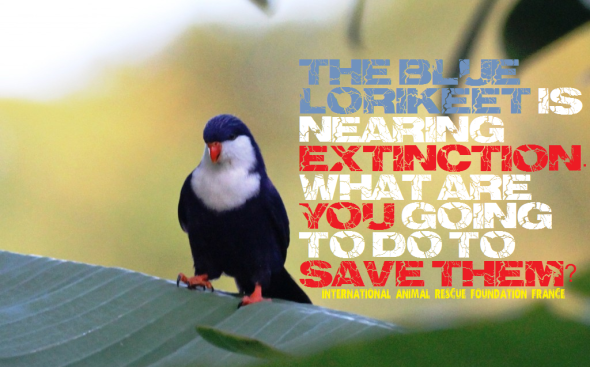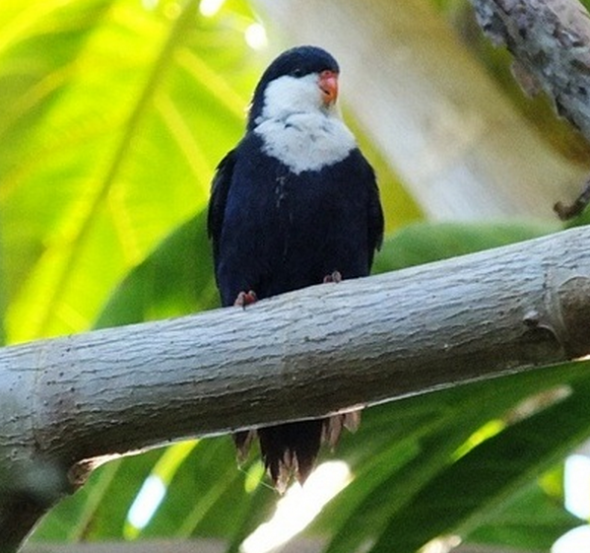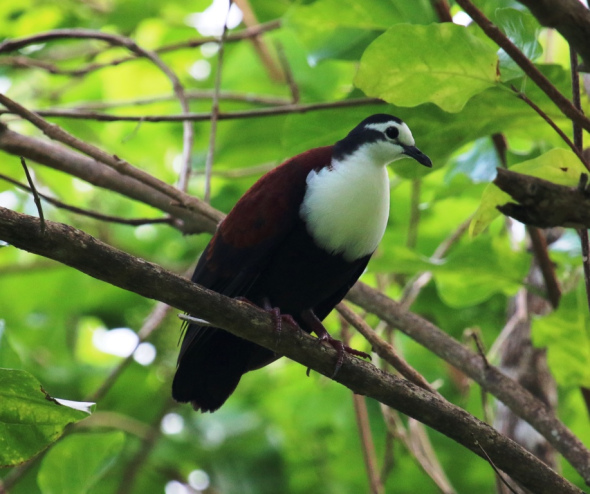
Endangered Species Monday: Vini peruviana
This Monday’s endangered species watch post (ESP) I document on a rather elusive bird that is rarely spoken about within the conservation theater or among animal rights organisations. Listed as (vulnerable) the species was formally identified by Professor Philipp Ludwig Statius Müller (April 25, 1725 – January 5, 1776) was a German zoologist. (Image V. peruviana, photographer Tara)
Statius Müller was born in Esens, and was a professor of natural science at Erlangen. Between 1773 and 1776, he published a German translation of Professor Linnaeus’s Natursystem. The supplement in 1776 contained the first scientific classification for a number of species, including the dugong, guanaco, potto, tricolored heron, umbrella cockatoo, red-vented cockatoo, and the enigmatic hoatzin. He was also an entomologist.
Despite the birds high population size the Blue Lorikeet-scientifically named as Vini peruviana is under threat from feral cats, accidental introduction of black rats and violent storms that hit the birds native range frequently causing untold damage and catastrophic destruction to the specie habitat. Furthermore the ‘swamp harrier’ remains an all out threat to Blue Lorikeet’s range which has led to wide range species decline. Swamp Harriers predate on the Blue Parikeet mainly due to the birds color.
Endemic to the Cook Islands and French Polynesia, Blue Lorikeet population sizes are declining quite fast of which drastic conservation measures are now required to control feral cats and the accidental introduction of black rats, not forgetting measures to either reduce swamp harriers or introduce a non-endangered prey for the harrier. The last survey which I believe was undertaken sometime back in 2012 showed a ‘global population’ estimated to be at 7,200 to 9,000 individuals. Which is still quite high, however not high enough to stop the species qualifying for the classification of (endangered).
Taking into consideration range and overall total population size (at an estimate) the species falls into the ‘band’ of 2,500 to 9,000 individuals. This equates (exactly) to 1,677-6,666 ‘mature individuals’ rounded to 1,500-7,000 mature individuals. Summarizing; the exact total population size could be as low as 1,500 but no greater than 7,000 mature individuals (which is extremely concerning).
Blue Lorikeet’s have been recorded within twenty of the south-east Polynesia islands, unfortunately on seven of these islands the species has since been declared officially extinct. The species now remains sparsely distributed on some thirteen islands of which is threatened by rats, feral cats and the swamp harrier. We now know the species is situated within the Society Islands (formerly all), the northern atolls of the Tuamotu Archipelago (both French Polynesia), and Aitutaki (Cook Islands).

Image: Blue Lorikeet - Vini peruviana
Within the Society Islands conservation teams estimated that there were some 200-400 individual pairs on the Motu One and Manuae respectively in 1973 , however this may no longer be the case. On the Maupihaa island back in 1999 conservationists that believed the species to be extinct located breeding pairs. In Tuamotus 2006 surveys have shown the following data in relation to population sizes; Kaukura (1,000), Rangiroa (1,000), Arutua (500), Apataki (200) and Tikehau (50).
Meanwhile in Tiamanu Motu in Apataki atoll a minimum 300 individuals were estimated back in 1989 (this sub-population being allegedly smaller than 10 years previously). On Aitutaki, where it was probably introduced, numbers have been estimated at under 500 pairs, 2,400 individuals and 1,000 individuals (2006).
Following the devastation of Cyclone Pat (2010) a further census was undertaken to asses the impacts of freak weather patterns and catastrophic cyclones on the species. Distance sampling surveys on the island of Aitutaki (2011) showed a decrease in population size of exactly 1,400 individuals. That’s quite a substantial decline of individuals caused directly by a single yet destructive cyclone.
Blue Lorikeets depend on coconut palms for nesting and some of its food, and will frequent cultivated areas. They also roost in palm trees, rising at dawn and calling and preening before feeding. They are usually found in small flocks of less than ten birds. They are active birds, feeding on nectar, insects, and ground forage.

Image: Swamp Harrier (Wiki) - . Circus approximans
Threats
The species’s extinction from many islands is most likely due to predation by black rat Rattus rattus and to a lesser extent, feral cats Felis catus. Blue Lorikeet’s have gone extinct from Makatea in the Tuamotus could have been accelerated by a particularly violent hurricane. Its range reduction in the Society Islands correlates with the spread of the introduced Swamp Harrier Circus approximans. The accidental introduction of black rats to the islands where Blue Loirkeet persists is a continuing threat to the species. Listed on Cites Appendix II conservation actions are under way with more projects proposed.
Thank you for reading.
Dr Jose. C. Depre
Botanical and Environmental Scientist.
August 17, 2015 | Categories: You must be the change you want to see in the world | Tags: (ESP), Birds, Blue, Blue Lorikeet, Cook Islands, Cyclone, Dr Jose Depre, Endangered Species Watch Post, Feral Cats, French Polynesia, I.A.R.F, International Animal Rescue Foundation, Jose Depre, Monday, Monday's animal, nature, population size, Professor Philipp Ludwig Statius Müller, Rats, Statius Müller, Swamp, Swamp Harrier, Vini, Vini peruviana, Vulnerable. IARF, Wildlife | 1 Comment

Endangered Species Friday: Alopecoenas kubaryi
This Fridays Endangered Species watch Post (ESP), I document on the Caroline Ground Dove scientifically identified as Alopecoenas kubaryi. The species was discovered and named back in 1880 by explorer Friedrich Hermann Otto Finsch (8 August 1839 - 31 January 1917, Braunschweig) was a German ethnographer, naturalist and colonial explorer. Since new data has emerged in relation to the species that Hermann identified, the bird has since been correctly renamed and placed into the correct specie table (please read more below). (Image: Alopecoenas kubaryi: Author unknown).
Listed as vulnerable populations are continuing to decline, and with such a small population size its quite likely this rather beautiful and peaceful little bird will soon meet the criteria for endangered listing on the threatened species list very soon.
Endemic to Micronesia there are no fewer than 250-999 ‘mature individuals’ remaining if that, (that’s incredibly depressed for a bird listed as vulnerable). This sadly equates to exactly 375-1500 individuals in total. In theory I’m perplexed as to why this beautiful bird hasn’t been re-categorized as critically endangered. Should the wild population continue to decrease at the rate it currently is there will be no time left to re-list this bird or, implement much stronger and professional conservation efforts that are already seen today.
As explained the species is native to the Federated States of Micronesia which is an independent sovereign island nation and a United States associated state consisting of four states – from west to east, Yap, Chuuk, Pohnpei and Kosrae which are situated and spread across the Pacific ocean. The Caroline Ground Dove (common name) is located mostly within the Pohnpei region.
From 1983-1984 within the Pohnpei region populations were said to be as high as 841 mature individuals. That would have equated back then to roughly just over 3,000 individuals in total. Back in 1994 another census was undertaken in relation to the species current population trend within the birds stronghold of Pohnpei.
Unfortunately the survey recorded a staggering decrease in overall population rates within the lowlands. Meanwhile back in 2001 a further survey was conducted which again showed a dramatic decline in population trends. A conservationist by the name of Dr Baker ‘alleged’ in 1951 that the Caroline Ground Dove populations have always been depressed.
I personally disagree with this statement and if populations were ‘surveyed’ to be declining then why wasn’t extreme conservation measures implemented back then to protect the species stronghold and establish a type of nature reserve to increase population sizes? Furthermore and as I have explained why hasn’t the species been listed as (critically endangered?). The evidence is more than clear that populations rather than being (small) have in fact (declined). Conservation efforts that are currently underway too are in my opinion way to late.
The Caroline Ground Dove is commonly known by the locals as; Caroline Ground-dove; Caroline Islands Ground-Dove or the White-fronted Ground Dove. Caroline Ground Dove’s scientific identification back in the 1880’s was put into the wrong (specie) listing commonly known as Gallicolumba kubaryi. However the bird has since been entered into the correct specie list, now known as Alopecoenas kubaryi. The genera remains the same.
Caroline Ground Doves are known to inhabit tropical or sub-tropical rain-forest of which their preferred habitat is normally within Hibiscus trees. The dove takes a preferential liking to the specie of Hibiscus known scientifically as Hibiscus tiliaceus. Unfortunately the areas from which the bird specie resides is normally within and/or around human settlements which sadly poses a direct threat to the bird due to habitat destruction from human settlements. The dove can also be located in lowland, mangrove and montane rain-forests too.
In the region of Chuuk the Caroline Ground Dove is normally seen inhabiting agricultural areas (again this can pose a significantly high threat) to the bird in general. Reports have also stated that some small populations were located on islets which would indicate coastal habitat is also preferred by the Caroline Ground Dove. Within the region of Weno where habitat is said to be degraded spotters have confirmed the bird may also prefer degraded habitat too.
Diet normally consists of seeds, worms, snails and insects. A. kubaryi normally nests in dense forest at around 180 meters inland. Within the Chuuk province conservationists have confirmed that nests with eggs in have been surveyed from the months of; February, April, June and September. So we know the species normally mates and nests all year round. However unlike other doves that normally lay in the region of 1-3 eggs within a clutch, the Caroline Ground Dove is only known to produce one egg per clutch. Again I question why the species hasn’t been listed as (critically endangered). How much evidence does one need?

Image: Alopecoenas kubaryi
Threats
On Pohnpei, predation by introduced species (mainly rats Rattus spp. and cats) and excessive hunting may have caused some depletion. Habitat loss is also a major issue. Overall, there was a reduction of undisturbed upland forest on Pohnpei of over 60% from 1975-1995.
The majority of the island’s forests have been, to varying degrees, converted or at least degraded to mixed forest (native species mixed with lowland secondary species), largely attributable to the cultivation of sakau (kava) Piper methysticum as a major cash-crop. The fragmentation of such forest by sakau clearings also introduces and encourages the spread of invasive species in isolated areas throughout the forest.
Although efforts over the past 20 years to reduce the amount of clear-cutting for sakau plantations have resulted in the slowing of native forest conversion rates, the trend remains negative. On Chuuk, the only remaining semi-original forest remains in tiny remnants on the higher reaches of a few islands.
Traditional leaders have been encouraged to adopt a programme to plant sakau in the lowlands, but resistance is high because the plant grows best on wet mountain slopes and is less likely to be pilfered in more remote areas. Watershed Forest Reserve boundary lines have been laid down and enforced in Madolenihmw and Uh on Pohnpei.
Proposed conservation actions (already now underway) and past conservation actions are in my expert opinion not good enough nor will they prevent this bird from going extinct within five years to seven years max. I do find it somewhat odd that the United States Fish and Wildlife Service haven’t steeped in here to increase more help. But then these islands really are not run by the United States Government. I personally believe the specie will be extinct in five years. Sadly not enough is being done to preserve this stunningly beautiful dove.
Thank you for reading.
Dr Jose Carlos Depre.
Environmental and Botanical Scientist.
[email protected]
For more information follow us on Facebook.
August 14, 2015 | Categories: You must be the change you want to see in the world | Tags: (ESP), Alopecoenas kubaryi, Animals, Baker, Bird, Birds, Caroline Ground Dove, cats, Chuuk, Conservation, critically endangered, Dove, Doves, Dr Depre, Endangered species, Federated States of Micronesia, Felines, Friday, Fridays Animal, Gallicolumba kubaryi, Hibiscus tiliaceus, IARF, International Animal Rescue Foundation Africa, Invasive species, J.C Depre, Jose Depre, Kosrae, Micronesia, Pacific ocean, Pohnpei, Rain Forest, Rats, Rattus spp, United States, USA, Wild Birds, Wildlife, Yap | Leave a comment







